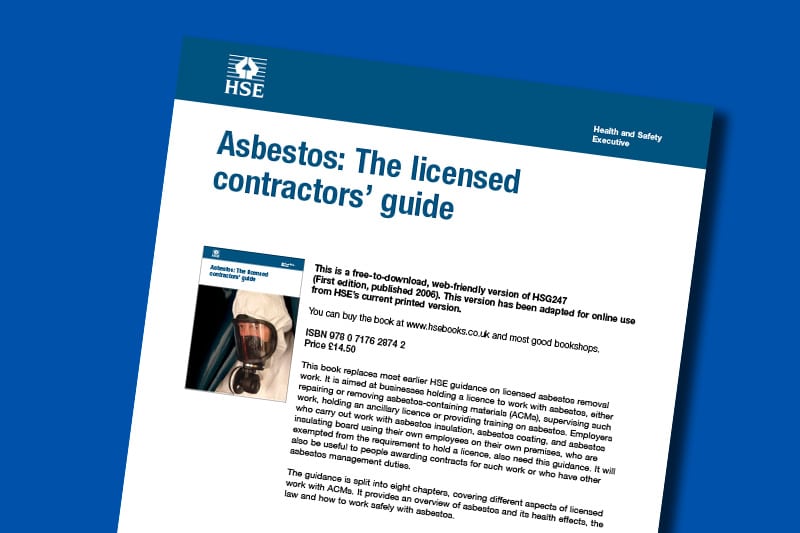What are the current asbestos regulations? Understanding HSG247
More than a generation has now passed since a final ban was imposed on all forms of asbestos in the UK – in late 1999 – but the legacy of the now-notorious substance’s once-widespread use continues to be evident. This should be no great surprise, given the combination of the now very well-known health risks associated with asbestos, and the estimation that as many as 1.5 million buildings in the UK still contain this carcinogen.
Key Points
- HSG247 is a comprehensive guide for UK businesses licensed to work with asbestos, detailing procedures for safe removal, handling, and training.
- As many as 1.5 million UK buildings still contain asbestos; HSG247 provides crucial information for managing this hazard responsibly.
- The guide covers risk assessments, use of personal protective equipment (PPE), decontamination, and legal compliance for asbestos work.
- Adherence to HSG247 is critical to protect workers’ health, prevent legal repercussions, and ensure public safety from asbestos-related diseases.

Asbestos was first commercially mined in the middle of the 19th century, and went on to be especially heavily used in the UK construction industry from around the 1950s until the 1980s. Over the course of the 20th century, asbestos was incorporated into an extremely wide range of products that found their way into domestic, commercial, industrial, and public buildings alike.
Examples of asbestos-containing materials (ACMs) – very considerable numbers of which remain present in UK buildings in the 2020s – include asbestos insulating board (AIB), floor coverings, textured decorative coatings, and asbestos cement roof tiles, to cite just a few.
Tragically, however, it wasn’t always widely understood – especially among the public – that in the event of asbestos fibres being released and subsequently breathed in by someone nearby, exposed individuals could face a significantly heightened risk of developing potentially fatal asbestos-related disease in later life. Even to this day, asbestos-related conditions such as mesothelioma cause around 5,000 deaths in the UK every year.
So, bearing all the above in mind, you can probably well understand why it is so important to comply with the stringent asbestos regulations that are in force in the UK today. But it can be difficult to know where to start in one’s efforts to ensure compliance.
This brings us onto the subject of the UK Health and Safety Executive (HSE)’s guidance documents on the subject of asbestos. One of these is Asbestos: The licensed contractors’ guide, which has the series code HSG247.
What is the HSG247 guide?
The HSG247 guidance document was first published in 2006, and a free copy can be downloaded in PDF form from the HSE’s website.
As its title, referencing licensed contractors, indicates, the HSG247 guide is principally aimed at businesses that hold a licence to work with asbestos. The term “work with” in this context refers to organisations that repair or remove ACMs, as well as those that supervise such work, hold an ancillary licence, or provide training in relation to asbestos.
The guide consists of eight chapters, addressing in detail a variety of aspects of licensed work with ACMs. Those chapters cover, in order:
- An introduction to working with ACMs
- Licences for work with ACMs
- Risk assessments, plans of work, and notifications for work with ACMs
- Training for employees, supervisors, and others working with ACMs
- Personal protective equipment (PPE) for work with ACMs
- Enclosures for work with ACMs
- Controlled techniques for the removal and repair of ACMs, including waste disposal
- Decontamination
Also contained in the HSG247 guide is a list of abbreviations – covering many of those you might have come across in your previous reading about asbestos, such as ACOP, HSE, and UKAS – as well as a final section comprising “references and further information”. This final part of the document should further reassure you that all the advice contained within is well-founded and informed.
Who is the HSG247 guide aimed at?
As stated above, the HSG247 guide is aimed at businesses that hold a licence to work with asbestos. Such “work” might entail the repair or removal of ACMs, the supervision of such work, and/or the delivery of asbestos training.
However, the audience for this guidance document might be slightly broader than its reference to Licensed contractors in its title may initially seem to imply. If, for instance, you are an employer that undertakes work with asbestos insulation, asbestos coating, and asbestos insulating board using your own employees on your own premises – and you are exempt from licensing requirements as a consequence of this – you will still need to read this guide.
The HSG247 document also makes invaluable reading for people who award contracts for such asbestos work, as well as for individuals who may have other asbestos management duties.
What do you need to know about the key knowledge areas?
Naturally, it is impossible to sum up in just a few paragraphs the full range of things you might need to know when you are undertaking licensed asbestos work – hence the need for guides such as HSG247 in the first place.
Still, the HSG247 document is likely to be very useful to you as you seek to educate yourself on such crucial factors as the various types of asbestos and the risks associated with them, as well as the legal and compliance requirements for asbestos removal work, and the health and safety guidelines that you should follow for your workers.
You might not have known, for example, that there are three main types of asbestos to have been commonly used – crocidolite (‘blue’), amosite (‘brown’), and chrysotile (‘white’) asbestos – and that while all types of this mineral are dangerous, crocidolite and amosite asbestos have an especially notorious reputation.
Similarly, you might be unsure about the circumstances in which ACMs should be removed from a building, or about what you need to be doing if you will be leaving asbestos in place at a site and managing it over time.
The HSG247 guide covers all these subjects in detail, and many more that are of relevance of licensed work with asbestos. So, you are likely to find it immensely informative as you seek to ensure safety and compliance in your management of asbestos.
What practical guidance for contractors does HSG247 give?
Contractors can quickly and easily consult the HSG247 document for guidance on a wide range of practical processes associated with licensable asbestos work.
Whether you are unsure what steps you should be taking as a contractor in the pre-removal stage with regard to planning and risk assessment, or you require in-depth information on the procedures you need to implement to help ensure the safe removal and disposal of asbestos, HSG247 will be greatly useful with all of this.
Licensed asbestos removal contractors should also be well-informed on the personal protective equipment (PPE) and other safety gear that need to be used during asbestos removal operations, not to mention the emergency procedures that should be followed in the event of asbestos fibres being accidentally released. Again, the HSG247 document provides crucial information on all these processes.
What are the compliance and documentation considerations of HSG247?
If you will be carrying out licensable work with asbestos, this must be notified to the appropriate enforcing authority, using the ASB5 form, at least 14 days prior to the work starting.
The right enforcing authority to notify will depend on the type of premises or activity. In the case of shops, offices, and launderettes, for example, the relevant enforcing authority will be the local authority (LA). In other cases – such as if the site is a factory, hospital, or construction or demolition site – it is the HSE that will require notification. Other enforcing authorities for certain sites include the Office of the Nuclear Regulator and the Office of Rail and Road.
HSG247 also makes clear that employees of licensed asbestos companies should not be permitted to begin work until they have received the appropriate level of training. There is an entire chapter of the guide dedicated to training, answering such questions as why training is needed, how you can identify and cater to training needs, and what records should be kept in order to show that workers have been suitably trained and possess the necessary level of competence.
Why is adherence to HSG247 is critical?
As a licensed asbestos removal contractor, you have the highest level of responsibility to ensure you are operating in complete compliance with the law and all relevant health and safety guidelines, which will be instrumental in protecting the health of workers and the wider public. The HSG247 document provides comprehensive information on how you can achieve this.
There can also be very serious legal implications for a contractor that falls short of such compliance; if, for instance, you carry out any licensable asbestos work without holding a licence, this constitutes an offence, and you risk being prosecuted.
Whats resources and further reading are there about HSG247?
As aforementioned, you can download a free copy of the HSG247 guide at the website of the HSE, which also makes available various other publications and guides in relation to asbestos. The HSE website as a whole also provides further useful information in relation to many different aspects of managing asbestos, including the current law, and both licensable and non-licensable work.
Other very useful resources for asbestos information include the website of the United Kingdom Asbestos Training Association (UKATA), which sets out the essentials of who should and should not carry out certain asbestos work.
Finally, we are also pleased here at Oracle Solutions to offer a comprehensive online Learning Centre with various insightful articles on important asbestos topics. You might also be interested in learning more about our licensed and accredited asbestos services, with the delivery of HSE-approved asbestos training courses being just one of our areas of expertise.
Conclusion: HSG247 will greatly inform your efforts to ensure safety and compliance
Whether it is specifically asbestos removal that you are looking to carry out as a licensed contractor, or you are among the other groups of people or organisations that stand to benefit from this guidance – such as those delivering asbestos training – you are likely to find the HSG247 invaluable in your efforts to educate yourself on various aspects of asbestos management.
By adhering to the guidelines set out in this document for whatever licensed asbestos work you are carrying out, alongside committing yourself to continuous education on all the topics the guide covers, you can greatly help ensure both the highest level of asbestos safety, and your compliance with the law.
Would you like to find out more about any of Oracle Solutions’ highly rated asbestos services, and to request a fast and free quote? If so, please don’t hesitate to call us today, or to send us an email.

Written by Jess Scott
Jess Scott has been an all-round asbestos consultant since 1996. That’s nearly 3 decades of asbestos knowledge. He spends his time sharing that knowledge with the team at Oracle and with their clients. Jess's goal is, and always has been, to use my expertise in helping people to comply with the law. This legal compliance ultimately helps to protect everyone from the harmful effects of asbestos. Jess has acted as an asbestos expert witness in legal cases and is involved in many asbestos educational activities throughout the UK.
